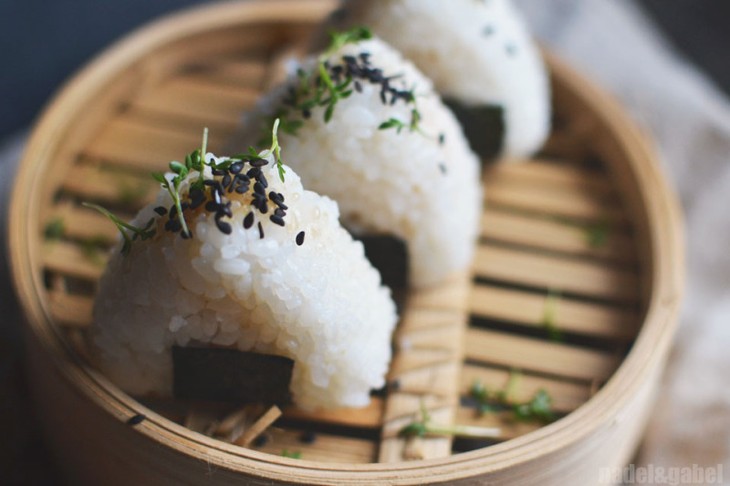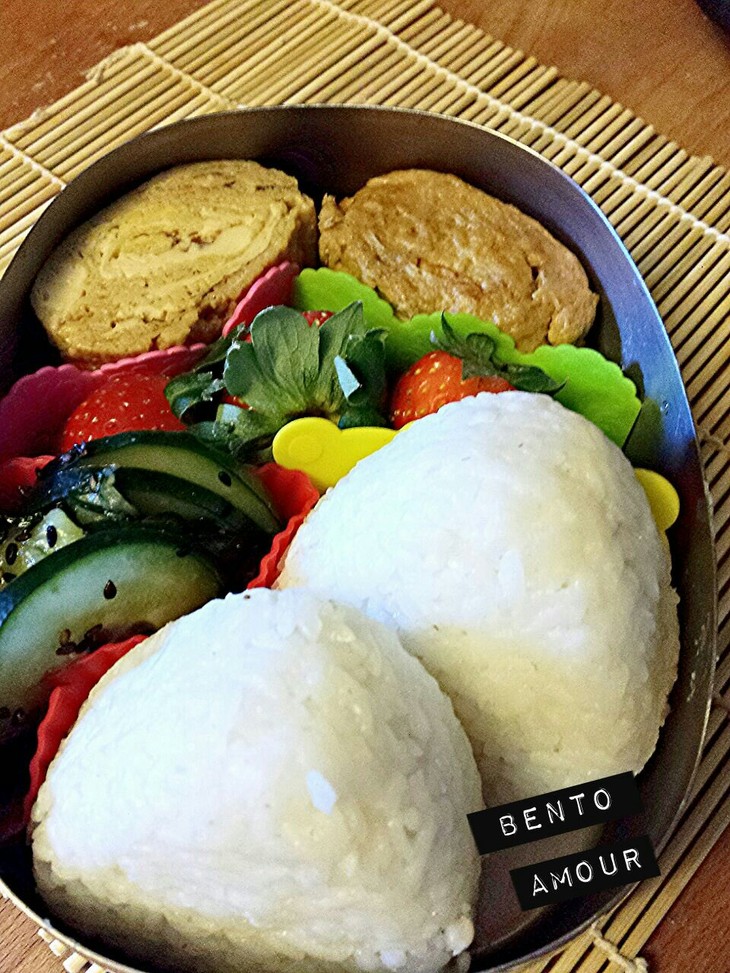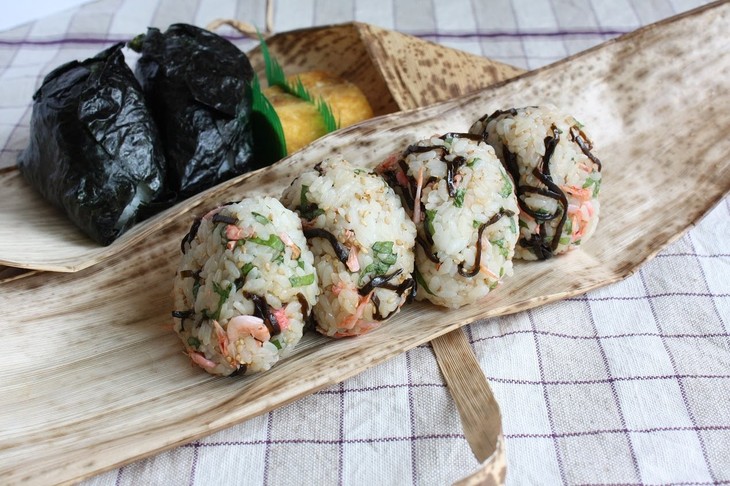(VOVworld) - At first glance, Onigiri- Japanese rice balls- seem too ordinary to represent the quintessence of Japan’s cooking arts, unlike a colorful tray of sushi. Yet, the simple-looking rice balls mean a lot- it is considered the symbol of family love in Japan.
America has hotdogs. England has sandwiches. Japan has Onigiri. Onigiri is a ball of packed white rice either mixed with or stuffed with savory condiments and wrapped in a sheet of seaweed. The name comes from the Japanese verb “nigiru”, which means “to pack something together with the hands”, in this case, white rice. There is hardly any dish that has matched the ups and downs of Japanese history like rice balls. As early as the 11th century, the talented female artist Murasaki Shikibu first mentioned a small round ball of rice in her diary. But some claim that making Onigiri might have preceded chopsticks! In any case, the recipe for Onigiri remains unchanged: freshly cooked rice, a piece of seaweed paper, and any filler that goes with rice.

Tetrahedron shaped onigiris are the most popular but also the most difficult to made.
Source: Nadel and Gabel Blog |
To Koga Hiroko, an educational expert at the Japan Foundation in Hanoi, creating an Onigiri from those humble ingredients was like creating a piece of art: “Onigiri comes in many shapes such as a ball, a tetrahedron or a cube. Among those, a tetrahedron Onigiri is the most difficult. You have to create a symmetrical tetrahedron using just your two hands. Those who lack experience tend to squeeze the rice balls very tightly into a triangular shape. However, the key to success is to mold the ball just twice or three times, so that you don’t crush the rice”.
The variety of Japanese rice balls is infinity. Any kind of rice can be used to make Onigiri: plain rice, flavoured rice, fried rice, or rice with red beans. The only requirement is that the rice has to be sticky enough so that it forms well into balls. Inside, you can put any food that you like. In the past, people used to prefer pickled plums, bonito flakes or salted salmon. Nowadays, new fillers such as tuna and mayonnaise are getting more popular. Ando Toshiki, Director of the Japan Foundation in Hanoi, believes that the popularity of different types of Onigiri varies with age.
“For old people like me, the traditional type of rice balls stuffed with pickled plum is the best. The taste of salty and sour plum is really refreshing and makes you feel more energetic. Pickled plum is the Japanese authentic flavour. That’s why when I heard that the most popular type of Onigiri is one with tuna and mayonnaise I was really surprised”.
Onigiri is one of the best loved snack foods in Japan thanks to its convenience. You can either make it at home or buy it at almost any local store. The fact that you can customize the fillers according with your personal taste explains the variety and deliciousness of Onigiri. Busy office workers eat Onigiri as a quick meal without side dishes. Japanese children often enjoy Onigiri in a colorful and elaborate Bento box. Ando said:“Onigiri can be enjoyed with side dishes like sweet egg rolls. Japanese mothers and grandmothers make their children a bento box with dark green and white Onigiri, yellow egg and red sausages that is very attractive to the children”.
 |
A colorful bento box served with two onigiris, egg rolls, pickled vegetable and fresh fruits.
Source: Obentoamor Blog
|
Pictures of children eating Onigiri are popular in Japanese magazines, comic books, movies, and TV dramas. They eat Onigiri at lunch, after school, and at school sporting events. Japanese housewives often have their own personal Onigiri recipe that makes each ball of rice or bento box a unique symbol of that love and creativity. Koga again: “Onigiri are not exactly an everyday food but they are very popular with Japanese people. To us Onigiri are a symbol of family love. Whenever we eat Onigiri, even ones from a convenience store, we think of our moms and grandmothers”.
Cultural exchanges are making Onigiri more familiar to students of Japanese culture. By organizing the program “Learning Japanese through making Onigiri” in Hanoi this September, the Japan Foundation hopes to bring one of Japan’s best cultural features to international friend: “By teaching them to make Onigiri, I hope to encourage Vietnamese people to learn more about Japanese culture and language. Those who already know Japanese will have one more interesting topic for conversation practice. Cultural exchanges help Japanese and Vietnamese people see the similarities and differences between their cultures. This can broaden one’s knowledge and appreciation of the other nation.”
The program attracted a lot of people to come, practice Japanese language and experience Japanese home-made tastes. Le Huong Giang, a 20-year-old student from the National University of Languages and International Studies, is a Japanese culture lover: “I think this program is very helpful for a specialist Japanese student like me. The activity works well in giving me more inspiration to learn the language. I have learned many more Japanese daily conversations through making Onigiri. What made me interested is that although it seems to be so simple, it takes skill to make those rice balls. I have failed to make tetrahedron Onigiri several times until Ms.Koga told me the secret”.
Onigiri is suitable for everyone, from children, students and housewives to busy workers. People may not understand its attraction until they discover what is inside the small rice balls. Nguyen Van Nguyen, a businessman in Hanoi who has been learning Japanese for two months, shared his feelings: “This is the first time I made and ate Onigiri. I think Onigiri fulfills the demand to be fast, cheap and tasty. I prefer healthy food, so I am very impressed by the way Japanese people use top-quality ingredients with no artificial additives and how they put creativity into the food. For me, this is not only a lesson in making rice balls but also a cultural activity that helps increase mutual understanding of the two peoples.”
 |
Onigiri has become a part of Japanese culture.
Source: howtomakeonigiri
|
Onigiri is Japanese soul food. It is not only a convenient and nutritious fast food for busy modern workers but also a symbol of family love and traditional values. By learning more about the humble Onigiri, you can discover some amazing of the hidden characteristics of Japanese cuisine and culture.